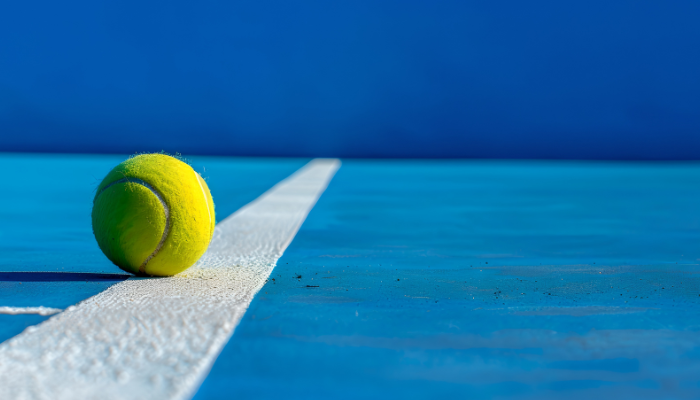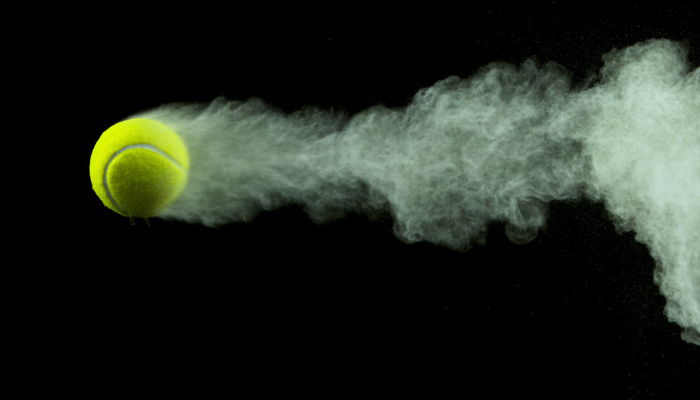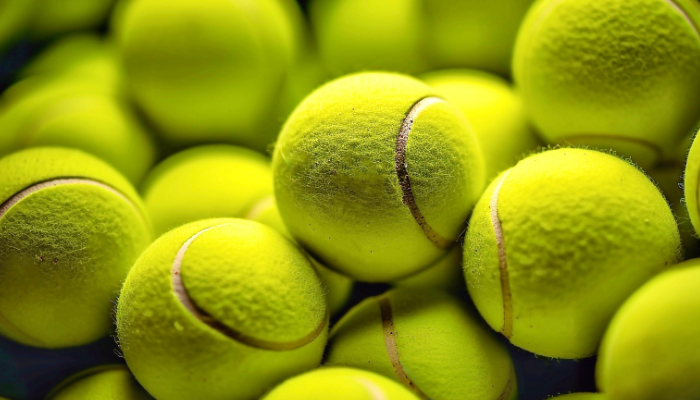
Why are tennis balls pressurized? Tennis balls are pressurized to enhance their bounce and responsiveness. During play, this is essential for dynamic and high-speed rallies.
In the following article, I’ll explain why are tennis balls are pressurized. I’ll also touch on the benefits and how they differ from their pressureless tennis balls. I’ll even answer the question of whether you can re-pressurize a dead tennis ball.
I am Chris, a British tennis player based in London, ERSA Pro Stringer, and a fan of all things tennis. I have spent hours researching this in-depth, so you don’t have to (you’re welcome!). Seeing as you got this far, let’s jump straight in! Feel free to skip ahead to the bit that interests you!
Why are tennis balls pressurized?
I don’t know about you, but I love those fuzzy yellow things. But have you ever wondered why are tennis balls pressurized?
Pressurized tennis balls are essential for competitive tennis. They provide consistent bounce and speed throughout a match.
If there weren’t any pressure, the balls would become flat and lose their bounce. Now, that wouldn’t be much fun to hit with!
Your shots would start to become slower, and the bounce would be unpredictable. But at least you can blame the ball when your shot goes long! I’m just kidding, but you get my point!
OK, I hear that, Chris, but how does the pressurization affect the performance of tennis balls?
To answer that, I need to go all geeky for a moment and talk about what tennis balls are made of.
They consist of an inner core made of rubber that basically surrounds a small amount of air. This air pressure creates tension within the rubber molecules. This air pressure is what gives the ball its bounce!
OK, the physics lesson is over for now!
There is some bad news, though. I’m sorry. This pressurization doesn’t last very long. Over time, this pressurization diminishes the more you hit with it. Exposure to different weather conditions also affects this.
The inside of a tennis ball

So we have answered why are tennis balls pressurized. But let’s look at the inside of a tennis ball.
Every element of a tennis ball is carefully designed and engineered for gameplay. It also allows you to play like Alcaraz [1]! Ok, maybe not Alcaraz, but one can dream, right?
Yes Chris, but why are tennis balls pressurized? Well, let’s get scientific for a moment and look the tennis ball material. If we look at what’s inside a tennis ball, it has the following
- The core: Each ball has a rubber centre, and it is this that gives the ball its bounce. But it’s not any old rubber; it is heated to increase its liveliness and feel off your racket.
- The felt cover: Back to the furry yellow thing again! The yellow felt is woven from wool and nylon fibers [2]. As a result, you get a drag effect when it flies through the air, allowing you more spin and control.
- Pressure: Each pressurized tennis ball has been filled with gas under high pressure. As a result, there is tension inside the ball, allowing it to bounce higher and faster – more on this later!
These pressurized tennis balls sound amazing, right? So, next time you step out on the court, take a moment to appreciate the science behind those furry yellow things! I write more about this in my article why are tennis balls pressurized.
What are pressureless tennis balls?
Pressureless tennis balls have a strong rubber shell, and they can feel a little heavier.
Unlike pressurized tennis balls, they don’t contain compressed air, allowing them to keep their bounce longer.
In comparison to pressurized balls, they bounce less and move slower.
So which is better I hear you ask? I’ll compare both, in the next section.
Pressureless tennis balls vs pressurized tennis balls
Let’s explore the advantages and disadvantages of pressurized tennis balls. I will compare them to pressureless tennis balls.
Pressurized tennis balls
| Advantages | Disadvantages |
| More lively feel during play | Not as durable |
| Good for spin and comfort | Lose their bounce over time |
| Ideal for matchplay | |
| Used in professional game |
Pressureless tennis balls
| Advantages | Disadvantages |
| Keep their bounce | Can be harsher on arm |
| Well suited to ball machines | Not ideally suited to matchplay |
| More cost effective | Feels heavier to hit with |
| Better for environment (less wastage) |
Why are tennis ball cans pressurized?
Why are tennis balls pressurized? Well, nothing beats that feeling when you crack open a fresh can of tennis balls and, of course, that lovely fresh ball smell!
But why do tennis balls come in a can and tell me why tennis balls are vacuum-sealed [3]?!? Well, it’s back to air pressure again!
Each container is designed to maintain the internal air pressure of the tennis ball. As a result, they stay fresh and bouncy for longer!
Each can is pressurized to 14 psi to match the internal pressure of the tennis ball. The can is vacuum sealed. The pressure inside helps the balls remain in tip-top condition until you are ready to play with them!
If they didn’t pressurize the can, too, the balls would be fairly flat and lose their bounce. And then you’d be all upset now, wouldn’t you? Plus, you wouldn’t get to smell that freshly opened can of balls. Go on, just admit it: you love it as much as I do!
How Long Do Pressurized Balls Last?

So, how long do pressurized tennis balls last? This does depend to some extent on the type of ball. They are designed to last a number of games before losing their bounce and pressure.
On average, tennis balls can maintain optimal performance for around 2-4 hours of play. This will depend, though, on how hard you hit them!
Have you ever noticed some balls are more expensive than others? What’s the difference, I hear you ask?
This will typically come down to the type and quality of materials used. Higher-quality materials tend to be more durable. They can then withstand a bit more hard-hitting!
But don’t forget the environment! The temperature, humidity, and heat all have an impact. Just how long these furry yellow things stay bouncy is determined by this.
Ok, now you have got me started! Did you know that high temperatures can cause the ball to lose pressure more quickly [3]? This is why you shouldn’t leave your tennis balls in a hot car!
Finally, how often you hit with the tennis balls and even how hard you hit them will also impact their lifespan. Constant use on hard surfaces such as asphalt or tarmacadam is also a factor in their longevity.
Can you repressurize tennis balls?
Can you bring dead tennis balls back to life? In other words, can you repressurize tennis balls?
In a word, yes. They may not regain their original performance, though. Please don’t try it at home or attempt a DIY method like using a hairdryer – it doesn’t work!
The way a tennis ball is made means that once the pressure is lost, it can be hard to get it back. Furthermore, wear and tear and temperature can affect the lifespan of a tennis ball.
If you want to attempt to repressurize a tennis ball, then you need a fancy machine. Unfortunately, these machines are rather expensive!
If you’re still not convinced and want to try it, then watch this video [4] where this chap explains how it’s done!
Over to you!
I hope you enjoyed reading the above article and do hope you visit again! Please check below for more related posts which might be of interest to you.

2 thoughts on “Why are tennis balls pressurized? Does it matter?”